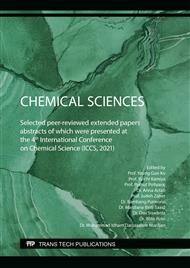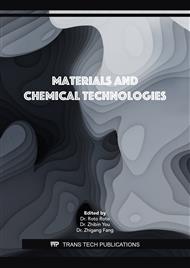[1]
S. Arum, Lebih Akrab dengan Insan Media, in Quarterly Magazine of PTPN X, July-September 2013, Jakarta, Indonesia, (2013).
Google Scholar
[2]
Directorate General of Estates, Tree Crop Estate Statistics of Indonesia 2018-2020 - Tobacco, December 2019, Jakarta, Indonesia, (2019).
Google Scholar
[3]
Anastasia, Cahyo, Yunita, Filosofi Budidaya Tembakau Cerutu Vorstenlanden, Yogyakarta, Indonesia, (2014).
Google Scholar
[4]
A. Santoso, D.E.K. Putri, M. Rusdi, S. Sumari, A.R. Wijaya, IB Rachman, The effect of basic catalyst concentration on tobacco oil transesterification (Voor-oogst) using ultrasonic wave and its potential as renewable energy, AIP Conf. Proc. 2330 (2021) 070008.
DOI: 10.1063/5.0043406
Google Scholar
[5]
M.Z. Ashirov, U.M. Datkhayev, D.A. Myrzakozha, H. Sato, K.S. Zhakipbekov, N.A. Rakhymbayev, B.N. Sadykov, Study of cold-pressed tobacco seed oil properties by gas chromatography method, Sci. World J. 2020 (2020) 8852724.
DOI: 10.1155/2020/8852724
Google Scholar
[6]
X. Zhang, H. Gao, L. Zhang, D. Liu, X. Ye, Extraction of essential oil from discarded tobacco leaves by solvent extraction and steam distillation, and identification of its chemical composition, Ind. Crops Prod. 39 (2012) 162–169.
DOI: 10.1016/j.indcrop.2012.02.029
Google Scholar
[7]
Y.G. Keneni, J.M. Marchetti, Oil extraction from plant seeds for biodiesel production, AIMS Energy. 5 (2017) 316–340.
DOI: 10.3934/energy.2017.2.316
Google Scholar
[8]
N. Usta, B. Aydoğan, A.H. Çon, E. Uğuzdoğan, S.G. Özkal, Properties and quality verification of biodiesel produced from tobacco seed oil, Energy Convers. Manage. 52 (2011) 2031–(2039).
DOI: 10.1016/j.enconman.2010.12.021
Google Scholar
[9]
Y. Tian, K. Chen, X. Li, Y. Zheng, F. Chen, Design of high-oleic tobacco (Nicotiana tabacum L.) seed oil by CRISPR-Cas9-mediated knockout of NtFAD2–2, BMC Plant Biol. 20 (2020) 233.
DOI: 10.1186/s12870-020-02441-0
Google Scholar
[10]
F. Jalili, S.M. Jafari, Z. Emam-Djomeh, N. Malekjani, V. Farzaneh, Optimization of ultrasound-assisted extraction of oil from canola seeds with the use of response surface methodology, Food Anal. Methods 11 (2017) 598–612.
DOI: 10.1007/s12161-017-1030-z
Google Scholar
[11]
D.B. Nde, A.C. Foncha, Optimization methods for the extraction of vegetable oils: A review, Processes 8 (2020) 209.
DOI: 10.3390/pr8020209
Google Scholar
[12]
International Standard, Paper and board – Determination of moisture content of a lot – Oven drying method, ISO 287, November 2017, Geneva, Switzerland, (2017).
DOI: 10.3403/30167167
Google Scholar
[13]
International Standard, Animal and vegetable fats and oils – Determination of acid value and acidity, ISO 660, March 2020, Geneva, Switzerland, (2020).
Google Scholar
[14]
International Standard, Animal and vegetable fats and oils – Determination of saponification value, ISO 3657, April 2020, Geneva, Switzerland, (2020).
Google Scholar
[15]
M.T. Mohammad, N.A. Tahir, Evaluation of chemical compositions of tobacco (Nicotiana tabacum L) genotypes seeds, Annu. Res. Rev. Biol. 4 (2014) 1480–1489.
DOI: 10.9734/arrb/2014/8211
Google Scholar
[16]
S. Majdi, M. Barzegar, A. Jabbari, M.A. Alikhani, Supercritical fluid extraction of tobacco seed oil and its comparison with solvent extraction methods, J. Agric. Sci. Technol. 14 (2012) 1043–1051.
Google Scholar
[17]
I.T. Stanisavljevic, M.L. Lazić, V.B. Veljković, Ultrasonic extraction of oil from tobacco (Nicotiana tabacum L.) seeds, Ultrason. Sonochem. 14 (2007) 646–652.
DOI: 10.1016/j.ultsonch.2006.10.003
Google Scholar
[18]
I. Stanisavljević, S. Lakićević, D. Veličković, M. Lazić, V. Veljković, The extraction of oil from tobacco (Nicotiana tabacum L.) seeds, Chem. Ind. Chem. Eng. Q. 13 (2007) 41–50.
DOI: 10.1016/j.ultsonch.2006.10.003
Google Scholar
[19]
I.T. Stanisavljevic, D.T. Velickovic, Z.B. Todorovic, M.L. Lazic, V.B. Veljkovic, Comparison of techniques for the extraction of tobacco seed oil, Eur. J. Lipid Sci. Technol. 111 (2009) 513–518.
Google Scholar
[20]
International Standard, Petroleum products – Determination of water – Coulometric Karl Fischer titration method, ISO 12937, November 2000, Geneva, Switzerland, (2000).
DOI: 10.3403/02487385u
Google Scholar
[21]
A. Mukhtar, H. Ullah, H. Mukhtar, Extraction and characterization of tobacco seed oil, Asian J. Chem. 18 (2006) 20–24.
Google Scholar
[22]
P.N. Giannelos, F. Zannikos, S. Stournas, E. Lois, G. Anastopoulos, Tobacco seed oil as an alternative diesel fuel: Physical and chemical properties, Ind. Crops Prod. 16 (2002) 1–9.
DOI: 10.1016/s0926-6690(02)00002-x
Google Scholar
[23]
C.A. Jude, Extraction, characterization and industrial applications of tobacco seed oil (Nicotiana tabacum), Chem. Mater. Res. 3 (2013) 19–21.
Google Scholar
[24]
M.A. Ali, M.A. Sayeed, R.K. Roy, S. Yeasmin, A.M. Khan, Comparative study on characteristics of seed oils and nutritional composition of seeds from different varieties of tobacco (Nicotiana tabacum L.) cultivated in Bangladesh, Asian J. Biochem. 3 (2008) 203–212.
DOI: 10.3923/ajb.2008.203.212
Google Scholar
[25]
Y. Lin, D. Kong, Z. Wang, Y. Chen, Z. Yang, C. Wu, H. Yang, L. Chen, Nitrogen application modifies the seed and oil yields and fatty acid composition of Nicotiana tabacum, HortScience 55 (2020) 1898–(1902).
DOI: 10.21273/hortsci15335-20
Google Scholar
[26]
Joint FAO/WHO Codex Alimentarius Commission, Codex Alimentarius: Standard for Named Vegetable Oils, World Health Organization: Food and Agriculture Organization of the United Nations, Rome, (2019).
DOI: 10.4337/9781786438935.00011
Google Scholar
[27]
R.N. Arancon, APCC Quality Standards for Coconut Product, Asian and Pacific Community, Jakarta, (2011).
Google Scholar



